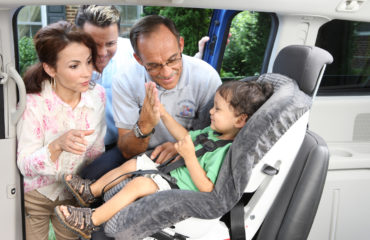Did you know that 73% of child safety seats are either not used when needed, or are installed incorrectly?[1]
Did you know that car crashes are the number one killer of children ages 1 to 12 in the United States?[2]
Did you know that correctly installed child safety seats reduce the risk of fatal injury by 71% for infants and 54% for toddlers?[3]
If you have young children, or know someone that has young children, then this article is for you, as I discuss the importance of a properly installed child safety seat.
Know the Type of Seat Needed
You just found out that you’re going to have a new daughter or son. Now what? Well, after telling the grandparents and other family and friends, it’s time to start looking for a child safety seat. Do you need to get one immediately? Of course not, but why wait? This will be an important item in keeping your child safe when you travel on the road.
First and foremost, infants should be in a “Rear-Facing” child seat, and it needs to be in the back seat. A rear-facing child seat is the safest type for your baby, as it helps protect the child’s head, neck and spine in a crash. Second, as a general rule, use a rear-facing seat for as long as the child fits in it, but also check the manufacturer’s instructions.
Another important question is, with the wide variety of child seats to choose from, which is the right one? The National Highway Traffic Safety Administration (NHTSA) evaluates all of the child safety seats and lists them in an “Ease-of-Use” 5 star rating. The evaluation covers:
- The labels
- The instructions
- Securing your child
- Installation, and
- Overall ease of use.
You can check out how your seat rates by clicking here.
 With your car seat in hand, now is absolutely the time to ask for some help. First, there is an easy checklist that you can use to see how you are doing. It was prepared by Safe Kids. Click here to download the checklist. Now is not the time to guess on how to correctly install a child’s safety seat. In a study done by Chrysler, 96% of parents believed they installed the child seat correctly, but based on research by NHTSA, 70% were installed incorrectly.[4] An improperly installed seat increases the risk of harm. But fear not, it is easy to get personal assistance, and it’s free. Across the US there are Child Passenger Safety Technicians (CPSTs) trained on how to properly install a child safety seat. To become certified, they have to attend a 3-4 day course that combines classroom instruction, hands-on activities, and a community check-up event. A CPST will check the installation of your car seat, and show you how to install it correctly. With over 120,000 CPSTs and 4,000 car seat events, you will be able to find one close by. To find the nearest event or technician, click here.
With your car seat in hand, now is absolutely the time to ask for some help. First, there is an easy checklist that you can use to see how you are doing. It was prepared by Safe Kids. Click here to download the checklist. Now is not the time to guess on how to correctly install a child’s safety seat. In a study done by Chrysler, 96% of parents believed they installed the child seat correctly, but based on research by NHTSA, 70% were installed incorrectly.[4] An improperly installed seat increases the risk of harm. But fear not, it is easy to get personal assistance, and it’s free. Across the US there are Child Passenger Safety Technicians (CPSTs) trained on how to properly install a child safety seat. To become certified, they have to attend a 3-4 day course that combines classroom instruction, hands-on activities, and a community check-up event. A CPST will check the installation of your car seat, and show you how to install it correctly. With over 120,000 CPSTs and 4,000 car seat events, you will be able to find one close by. To find the nearest event or technician, click here.
Know When to Change the Seat
Of course, children grow up, and before you know it, your child will no longer fit in the car seat. It’s now time to change to a forward-facing car seat, but still keep it in the back seat of the car. A child can remain in a forward-facing seat until about 65-80 pounds depending on the car seat. Be sure to periodically check the manual to understand the limitations of your child’s car seat during this period.
NHTSA has a great breakdown of age and the type of seat a child should be using:
Birth – 12 months
- Your child under age 1 should always ride in a rear-facing car seat. There are different types of rear-facing car seats: Infant-only seats can only be used rear-facing. Convertible and 3-in-1 car seats typically have higher height and weight limits for the rear-facing position, allowing you to keep your child rear-facing for a longer period of time.
1 – 3 years
- Keep your child rear-facing as long as possible. It’s the best way to keep him or her safe. Your child should remain in a rear-facing car seat until he or she reaches the top height or weight limit allowed by your car seat’s manufacturer. Once your child outgrows the rear-facing car seat, your child is ready to travel in a forward-facing car seat with a harness.
4 – 7 years
- Keep your child in a forward-facing car seat with a harness until he or she reaches the top height or weight limit allowed by your car seat’s manufacturer. Once your child outgrows the forward-facing car seat with a harness, it’s time to travel in a booster seat, but still in the back seat.
8 – 12 years
- Keep your child in a booster seat until he or she is big enough to fit in a seat belt properly. For a seat belt to fit properly the lap belt must lie snugly across the upper thighs, not the stomach. The shoulder belt should lie snug across the shoulder and chest and not cross the neck or face. Remember: your child should still ride in the back seat because it’s safer there.[5]
You might be tempted to purchase a used car seat. However, you should never use a car seat that has already been in a crash, so a word of caution: if you choose to buy a used one, buy it from someone you know to be sure it’s crash-free.
Lead by Example
And speaking of buying car seats, while the parents are the adults and must take responsibility for the child’s safety, as well as lead by example, parents of toddlers and older children might want to decide on two or three options, and then let the child make the final selection for “his” or “her” seat. Young children have an innate sense of “mine.” Allowing them a say in their own car seat–choosing the one with the pretty colors or the cool cup holder–can also be the beginning of fostering in them a lifelong understanding of the need to make “safe” choices.
Using the right car seat, installed in the right way is one of the most important safety actions any parent can take. Don’t wait ‘til tomorrow; now is the time to do it.
How about you? Have you tried to install a child’s car seat only to throw up your hands?
[1] Safe Kids Worldwide. 2013. Retrieved from: www.safekids.org/safetytips/field_risks/car-seat.
[2] Safer Car Website. 2013. This website is a gateway to information and resources for keeping your kids safe when they are on the move. You will find answers to the most common questions you may have – whether you’re buying their first car seats or handing your teen their first sets of car keys. Should you let your kids walk to school? What about bikes or the big yellow school bus? How safe is my car? This website can help you with all these answers and many more. www.safercar.gov. Fact retrieved from: www.safercar.gov/parents/CarSeats.htm.
[3] National Transportation Safety Board (NTSB). 2013. School Transportation Safety.








[…] Child Safety Seats: The Right One at the Right Time (trafficsafetyguy.com) […]